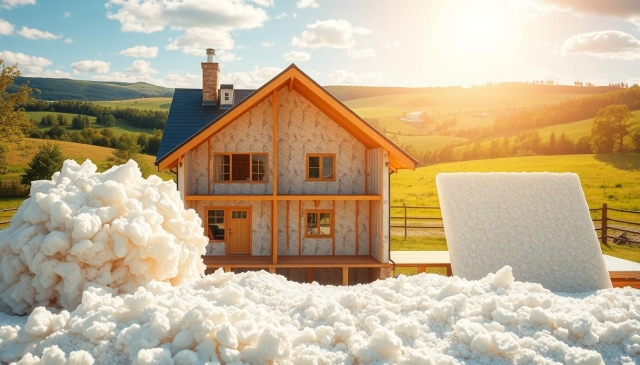Did you know that about 25% to 30% of the energy used for heating and cooling in homes is due to air leaks? This surprising statistic shows how important insulation is for an energy-efficient home. With the right insulation, homeowners can save on energy costs and stay comfortable all year.
In this article, we will look at different energy-saving insulation options. We'll focus on sustainable materials and strategies for your home. You'll learn why insulation is key, how to spot when it needs an upgrade, and how to make your home more eco-friendly and cost-effective.
Understanding the Importance of Insulation
Insulation is key to a cozy and energy-saving home. It stops heat from flowing, keeping your home at a good temperature. Knowing about insulation helps you choose the best options for saving energy.
What is Insulation?
Insulation is stuff in buildings that slows down heat transfer. It keeps your home warm in winter and cool in summer. There are many types, like fiberglass and spray foam, each with its own benefits.
Benefits of Proper Insulation
Good insulation offers many advantages:
- It cuts down on energy costs by reducing heat loss and gain.
- It makes your home more comfortable by keeping temperatures steady.
- It also reduces outside noise.
- It's good for the planet by lowering carbon emissions.
- It can even make your home more valuable by saving energy.
How Insulation Works
Insulation keeps your home cozy and saves energy. It blocks heat flow in three ways: conduction, convection, and radiation. This makes your home more comfortable and cuts down on energy use.
Mechanisms of Heat Flow: Conduction, Convection, and Radiation
Heat moves through materials like walls or ceilings by conduction. Convection happens when air moves, with warm air rising and cool air falling. Radiation is when heat moves through electromagnetic waves. Insulation products work to stop these heat flows, keeping your home's temperature steady.
Understanding R-Values and Their Significance
The R-value shows how well insulation blocks heat. A higher R-value means better insulation. This is key for keeping your home warm in cold weather and cool in hot weather.
Choosing the right insulation based on R-values can save a lot of energy. It also makes your home more comfortable to live in.
Signs Your Home Needs Better Insulation
Homeowners should watch for signs of poor insulation that can harm comfort and increase energy costs. Knowing these signs is key to keeping your home energy-efficient. Here are important signs your home might need better insulation.
Identifying Drafty Rooms
Cold drafts in certain rooms are a clear sign of poor insulation. These drafts usually come from bad insulation around windows, doors, and walls. You might notice:
- Chilled air near windows or exterior doors
- Uncomfortably cold floors
- Rooms that feel significantly colder than others
Spotting these drafts can show you where to improve, helping you find the right insulation for energy efficiency.
High Energy Costs Indicating Poor Insulation
High energy bills in winter often mean your insulation isn't doing its job. Without good insulation, homes need more heat, leading to higher bills. Keep an eye on:
- Comparing current heating costs with previous years
- Noting increases during colder months
- Identifying patterns associated with energy use
Fixing these high energy costs usually means checking your insulation's quality and type. Looking into energy-efficient insulation solutions can improve comfort and cut costs.
Energy-Efficient Insulation Solutions
Choosing the right insulation is key to making your home more energy-efficient. There are many types of insulation materials, each with its own benefits. Knowing about these materials helps homeowners make smart choices for comfort and savings.
Types of Energy-Efficient Insulation Materials
There are many energy-efficient insulation materials to choose from. Here are some common ones:
- Fiberglass: Fiberglass is a popular choice because it's effective and affordable.
- Cellulose: Made from recycled paper, cellulose is a green option that insulates well.
- Foam Boards: These rigid panels have high R-values and are great for basements and exterior walls.
How to Choose the Right Insulation for Your Home
Choosing the right insulation involves looking at several factors. Consider the R-value needed for your area, how easy it is to install, and its environmental impact. Think about your specific needs to improve energy efficiency and save money in the long run.
|
Insulation Type |
R-Value per Inch |
Sustainability |
Cost |
|
Fiberglass |
2.9 - 4.3 |
Moderate |
Low |
|
Cellulose |
3.1 - 3.8 |
High |
Moderate |
|
Foam Boards |
5 - 6.5 |
Varies |
High |
Eco-Friendly Insulation Options
Looking to make your home more energy-efficient? Check out eco-friendly insulation options. These materials help make your home sustainable, improve air quality, and keep it cozy. Using natural and recycled materials for insulation cuts down on environmental harm and keeps your home warm or cool.
Natural Fiber Insulation
Natural fiber insulation is great for those wanting a green home. Materials like sheep wool, hemp, and cotton are good for the planet and keep your home warm. Sheep wool controls moisture, hemp is durable and pest-resistant, and cotton is made from recycled denim.
Recycled Material Insulation
Recycled material insulation is perfect for eco-conscious builders. It's made from recycled denim and paper, creating a warm barrier while supporting recycling. It also reduces waste and saves resources, fitting well with green building goals. Using these materials can greatly reduce your carbon footprint.
Cost-Effective Insulation Solutions
Homeowners want to make their homes more energy-efficient without spending too much. Different insulation types have different costs and benefits. It's important to compare them to choose the best for your home.
Comparing Costs of Different Insulation Types
When looking at insulation for your home, consider these popular materials:
|
Insulation Type |
Average Cost per Square Foot |
Energy-Efficiency Rating |
|
Fiberglass Batts |
$0.50 - $2.00 |
R-11 to R-38 |
|
Spray Foam |
$1.00 - $3.50 |
R-5 to R-6 per inch |
|
Cellulose |
$0.75 - $2.00 |
R-12 to R-40 |
This table shows the range of insulation options. Some may cost less upfront, but they might not save as much money in the long run.
Rebates and Incentives for Insulation Upgrades
Homeowners should look into rebates for insulation upgrades. Utility companies and government programs offer money back for energy-efficient insulation. These rebates can lower the cost of better insulation, making energy-saving projects more affordable.

Knowing about these options helps homeowners save money upfront and in the long run. The right choice improves comfort and sustainability in your home.
Insulation for Energy Efficiency in Different Rooms
Improving energy efficiency at home starts with focusing on key areas like attics and basements. These spaces are where heat loss often happens. So, it's important to insulate them well to keep your home cozy and cut down on energy bills.
Insulating these areas not only saves you money. It also makes your home more comfortable to live in.
Attics: The Most Common Overlooked Area
Many people don't realize how important attic insulation is. This area can lose a lot of heat, which is bad in cold weather. Upgrading attic insulation helps keep your home warm in winter and cool in summer.
Choosing the right insulation here can really cut down on heating and cooling costs. This means your home will work better all year long.
Basements: Insulating Below Ground Level
Basements can be tricky to insulate because of their location. If not insulated well, basements can get damp and be too hot or cold. The right insulation can solve these problems and make your home more energy-efficient.
This makes your basement a more comfortable place to be. It also helps you control the temperature and humidity better.
Air Sealing: A Crucial Step in Insulation
Air sealing is key to making insulation work better in homes. Without fixing gaps and leaks, even top insulation can't save energy well. Finding where air leaks happen can really help save energy.
Common Air Leakage Areas in Homes
Many people miss spots where air leaks happen. Common places include:
- Windows
- Doors
- Electrical outlets
- Attic hatches
- Basement windows
- Vents and ductwork
Knowing these spots makes it simpler to seal air leaks.
Methods for Effective Air Sealing
Using the right air sealing methods can make a big difference. Here are some ways to do it:
- Applying caulk around windows and doors to seal cracks and gaps
- Using weather stripping to insulate doors and hatches
- Installing outlet gaskets for electrical outlets
- Utilizing foam sealant for larger cracks
Using these methods with good insulation can make homes more comfortable and save energy.
Environmental Impact of Poor Insulation
Proper insulation is key to reducing our environmental impact. Without enough insulation, homes use more energy, which means more greenhouse gas emissions. By improving insulation, we can lower our carbon footprint and live more sustainably.
Reducing Your Carbon Footprint with Proper Insulation
Good insulation cuts down on energy needs. This means homes need less heating and cooling. With less energy use, we burn fewer fossil fuels, which helps fight climate change.
Choosing sustainable insulation options is a smart move. It keeps our homes cozy while protecting the planet.
Energy-Saving Benefits of Sustainable Insulation Products
Sustainable insulation products save energy and are good for the environment. They're made from recycled or natural materials, so they're eco-friendly. By using these products, we can save money on bills and help the planet.
Investing in sustainable insulation is a way to make our planet healthier. It's a step in the right direction for a greener future.
|
Insulation Type |
Carbon Footprint Reduction |
Energy Savings |
Source Material |
|
Fiberglass |
Moderate |
Up to 30% |
Recycled Glass |
|
Cellulose |
High |
Up to 40% |
Recycled Paper Products |
|
Sheep's Wool |
High |
Up to 20% |
Natural Fibers |
|
Spray Foam |
Moderate |
Up to 50% |
Petrochemical Products |
For homeowners in colder climates, energy-efficient insulation solutions in Calgary are helping reduce heating costs while improving year-round comfort and sustainability
Choosing Professional Help for Insulation Installation
Deciding between professional installation and DIY insulation is important for your home. Homeowners should think about their skills, budget, and project needs. Knowing what to look for in a contractor helps make a good choice.
What to Look for in a Contractor
Choosing a professional means finding the right insulation contractor. This ensures the job is done right and fast. Here are important things to consider:
- Experience: Choose a contractor with a good track record in insulation.
- Licensing and Insurance: Make sure the contractor is licensed and insured to protect you and your home.
- References and Reviews: Check what past customers say to see if they were happy with the service.
- Warranties: Ask about warranties on work and materials for extra peace of mind.
DIY vs. Professional Installation: Pros and Cons
Choosing DIY insulation or professional installation has its own benefits and drawbacks:
|
Aspect |
DIY Insulation |
Professional Installation |
|
Cost |
Usually cheaper because you save on labor costs. |
More expensive because of labor costs, but may get better deals on materials. |
|
Time |
Can take longer, depending on your skill and time. |
Generally faster because pros have the skills and tools. |
|
Quality |
Quality varies based on your experience and technique. |
Usually better quality and follows local codes. |
|
Warranty |
Usually no warranty offered. |
Often comes with a warranty, protecting your investment. |
Maintaining Your Insulation Over Time
Regular insulation maintenance is key to keeping your home energy-efficient. Insulation can face issues like moisture, pests, and wear over time. It's important for homeowners to check their insulation's condition to keep it working well.
How to Inspect and Maintain Insulation
Inspecting your insulation needs a careful plan. Begin by checking the attic and basement, as they're more prone to damage. Look for:
- Visible signs of moisture
- Physical damage like tears or compressions
- Rodent or insect infestations
To maintain insulation well, remember these steps:
- Inspect insulation at least once a year.
- Seal any gaps or cracks in the home's structure.
- Replace or repair damaged insulation promptly.
Signs of Moisture and Damage to Look For
Spotting signs of insulation damage early can save you money. Look out for:
- Staining or discoloration on walls or ceilings
- Unusual odor, suggesting mold or mildew
- A significant increase in energy bills
Regularly checking these signs will help keep your insulation in top shape. This way, your home can reach its full energy-saving capacity.
Conclusion
Investing in energy-efficient insulation is key for a cozy home and lower bills. Homeowners should check their insulation needs and pick the best materials. This makes homes better and helps the planet.
Improving insulation and air sealing saves a lot of energy. Every small change helps cut down energy use and supports a green future. It's now a must for those who care about the environment.
As new technologies come, so does the need for better insulation. It makes homes more comfortable, cuts down on expenses, and supports a green lifestyle. Making smart choices now means a better, greener tomorrow.
FAQ
What is the best type of energy-efficient insulation for my home?
The best insulation for your home depends on your needs and where you live. Options like fiberglass, cellulose, and foam boards are common. Eco-friendly choices, such as natural fibers and recycled materials, are also great for a green home.
How can I tell if my home needs insulation upgrades?
Look for signs like drafty rooms and high energy bills. Cold floors and moisture issues, like mold, also mean you might need better insulation. Fixing these problems can make your home more comfortable and save money.
Are eco-friendly insulation materials as effective as traditional options?
Yes, eco-friendly insulation like sheep wool and hemp works well. They offer good thermal resistance and can be as efficient as traditional materials. Plus, they help keep your air clean.
What is an R-value, and why is it important for insulation?
R-value shows how well insulation keeps heat in. A higher R-value means better insulation. This is key for keeping your home warm or cool, no matter the weather.
How can I reduce costs when upgrading my insulation?
To save money, look at different insulation types. Fiberglass is affordable, while spray foam is more expensive. Check for rebates from local utilities or government programs to help with costs.
What areas of my home should I focus on for insulation?
Focus on your attic and basement for insulation. These areas lose a lot of heat. Adding insulation here can save a lot of energy.
What is the role of air sealing in insulation?
Air sealing stops energy loss by sealing gaps and leaks. Common spots include windows, doors, and outlets. Sealing these areas with insulation makes your home more energy-efficient.
Can I install insulation myself, or should I hire a professional?
Some people choose to do insulation themselves. But, professionals ensure it's done right and meets local codes. They also offer warranties. Think about your skills and the project's complexity before deciding.
How can I maintain my insulation over time?
Keeping your insulation in good shape is important. Check for moisture, damage, or pests regularly. Fixing problems early keeps your home energy-efficient.
What are the environmental benefits of investing in insulation?
Insulation cuts down on energy use and carbon emissions. It makes your home healthier and helps the planet. Sustainable insulation is a smart choice for the environment.






